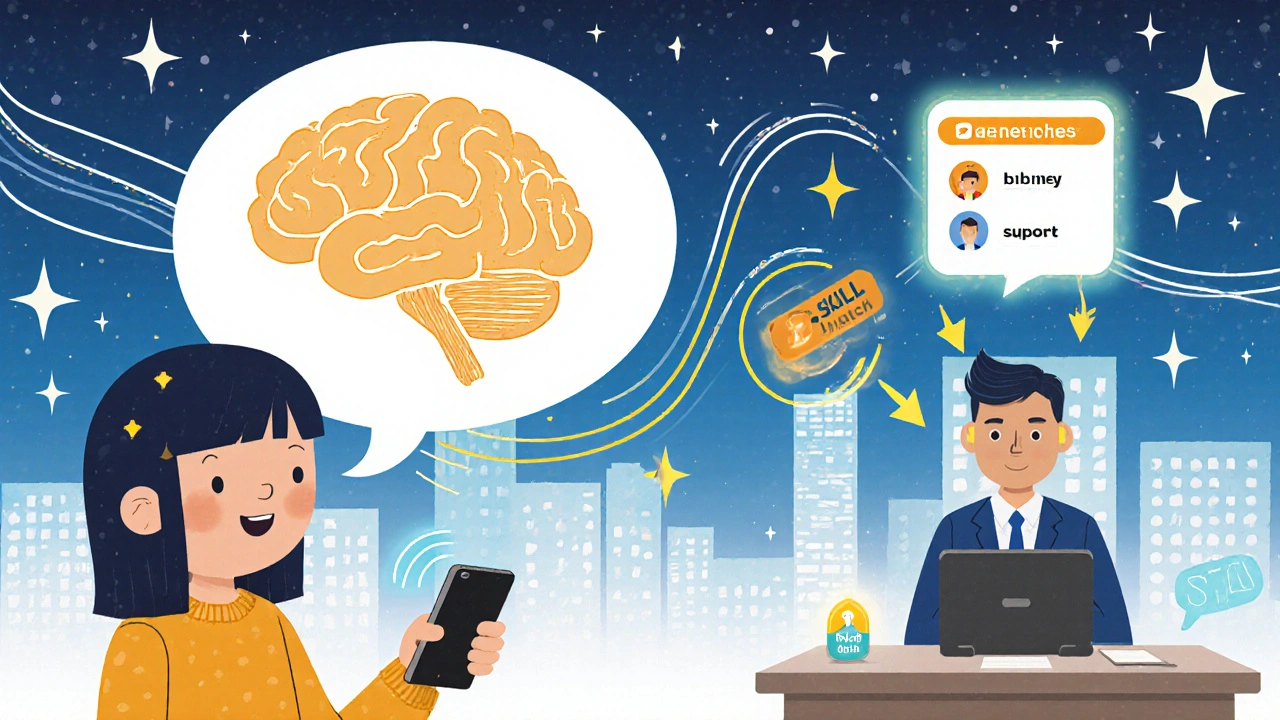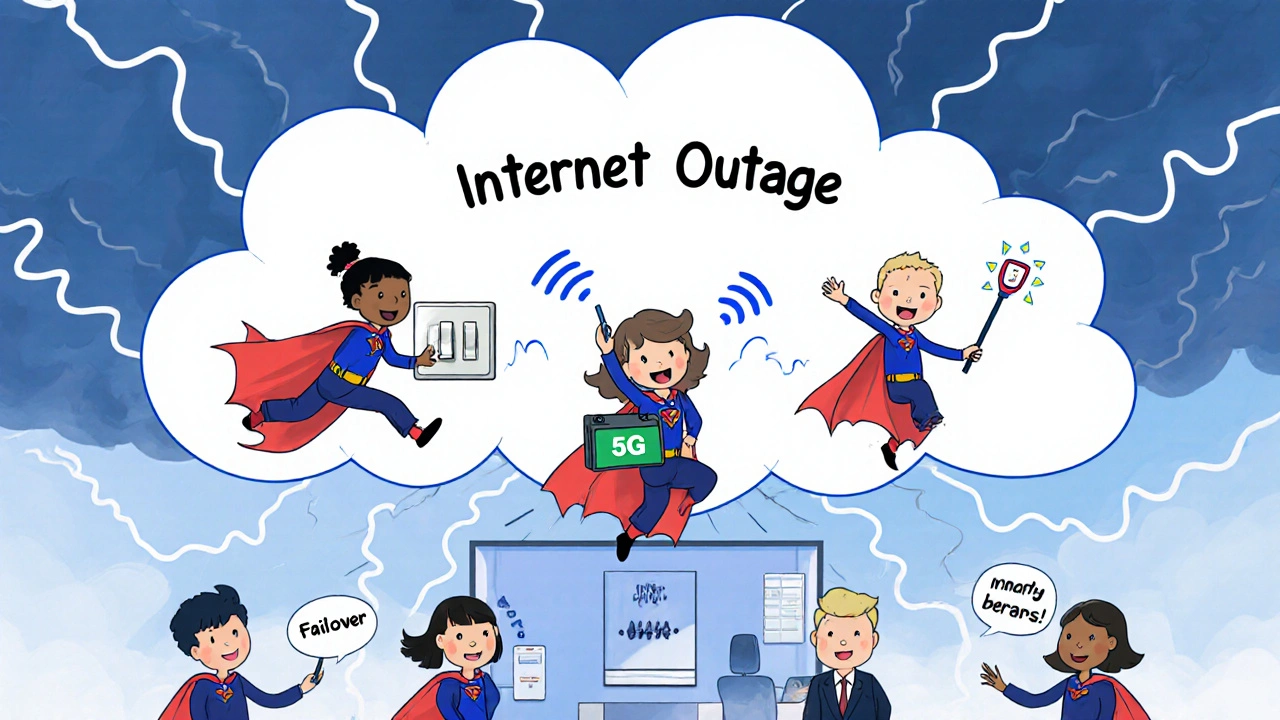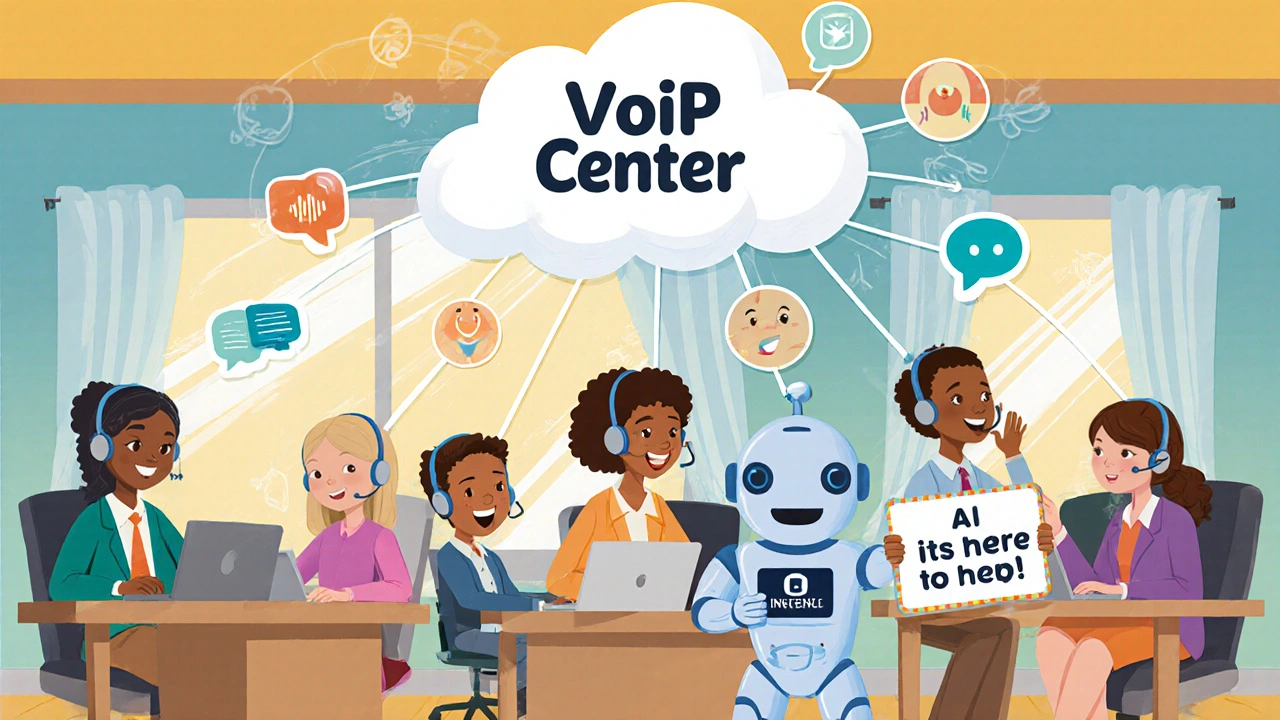By 2025, VoIP call center solutions aren’t just replacing old phone systems-they’re rewriting how businesses talk to customers. No more bulky hardware, long installation times, or static call queues. Today’s systems run on the cloud, use AI to predict customer needs, and handle voice, video, chat, and email-all from one dashboard. If your call center still relies on traditional phone lines, you’re already behind.
How VoIP Call Centers Work (No Tech Degree Needed)
VoIP stands for Voice over Internet Protocol. Instead of using copper phone lines, it sends your voice as digital data over the internet. That’s it. But what makes it powerful for call centers is what happens after that.
Every call gets routed through a cloud platform. When a customer dials your number, the system checks who they are, what they’ve asked before, and which agent is best suited to help-based on skills, language, or even past success rates. All of this happens in under a second. No switches, no physical wiring, no waiting for a technician to install a new line.
Modern systems need only a stable internet connection. Each call uses about 100 Kbps of bandwidth. That’s less than a single HD video stream. With 5G and fiber networks now common, latency is down to 1-10 milliseconds. That means no lag, no dropped words, no “Can you repeat that?”
Core Features That Actually Matter
Not all VoIP call center features are created equal. Here are the ones that make a real difference:
- Interactive Voice Response (IVR): Gone are the days of “Press 1 for sales, 2 for support.” Modern IVR uses natural language processing. Customers can say, “I want to change my billing address,” and the system understands it. Loris.ai reports AI-powered IVR now correctly interprets 95% of spoken requests-up from 62% just three years ago.
- Automatic Call Distribution (ACD): This isn’t just about who’s next. Skills-based routing matches customers with agents who’ve handled similar issues before. One financial services company saw first-call resolution jump from 58% to 92% after implementing this.
- Real-Time AI Analytics: Every call is analyzed as it happens. Sentiment analysis detects frustration, anger, or satisfaction. AI flags when a customer is about to hang up and nudges the agent with tips like, “They mentioned pricing twice-offer a discount.”
- Omnichannel Support: Customers start on chat, switch to voice, then follow up via email. The system remembers it all. No more “Can you repeat what you told the chatbot?”
- Call Summarization: After each call, AI generates a summary: “Customer called about late fee waiver. Denied due to policy. Offered payment plan. Customer agreed.” Saves agents 2-3 minutes per call.
Cost Savings You Can’t Ignore
Switching from traditional phone systems to VoIP cuts costs in three big ways:
- Hardware: No PBX boxes, no phone lines. Everything runs on existing laptops, phones, or tablets.
- Bandwidth: One internet connection handles all calls. Traditional systems need separate lines for each agent.
- Scalability: Adding 100 agents? Click a button. No truck rolling out with new phones. Talkroute helped a global e-commerce company scale from 50 to 1,200 agents in 72 hours.
Convoso’s 2025 benchmark found VoIP reduces call center costs by 40-60% compared to PRI systems. Aircall starts at $30 per user per month. Nextiva runs $79.95. Enterprise platforms like RingCentral or Five9 go over $100-but they include AI, analytics, and compliance tools you’d pay extra for elsewhere.
Security Isn’t an Afterthought
Yes, using the internet sounds risky. But modern VoIP platforms are more secure than old phone lines.
All traffic is encrypted with TLS 1.3 and SRTP. Caller ID is verified using STIR/SHAKEN, a federal standard that blocks spoofed numbers. FCC requires this for all U.S. providers since June 2023.
For industries like healthcare or finance, platforms offer HIPAA and PCI-DSS compliance out of the box. Data stays in encrypted cloud vaults, not on local servers. Even remote agents logging in from home are protected by the same protocols as HQ.

What Goes Wrong-and How to Avoid It
VoIP isn’t magic. It fails when people ignore the basics.
- Internet outages: 22% of businesses had service disruptions during ISP failures in 2024. Solution? Use a secondary internet line or 4G/5G failover. Some platforms auto-switch to mobile data if the main connection drops.
- Bad IVR design: Too many menu options? Customers hang up. One retailer’s IVR had 8 levels. After simplifying to 3, call abandonment dropped by 41%.
- Over-automation: Forrester found 43% of customers want a human for complex issues. AI should handle simple questions-balance is key. Use chatbots for password resets, not divorce proceedings.
- Hidden fees: Some providers charge extra for minutes beyond the plan. Always check usage caps. A customer on Aircall got hit with $1,200 in overage charges during a holiday rush.
A mid-sized retailer lost $287,000 in sales in 2024 because their failover system wasn’t tested. Don’t be that company.
Who’s Leading the Market?
Not all platforms are built the same. Here’s who’s winning in 2025:
| Platform | Market Share | Best For | Starting Price (per user/month) |
|---|---|---|---|
| Five9 | 31% | Large contact centers, pure-play CCaaS | $120 |
| RingCentral | 22% | Hybrid teams, CRM integration | $40 |
| Zoom Phone | 18% | Teams already using Zoom | $50 |
| 8x8 | 14% | Global teams, compliance-heavy industries | $35 |
| Aircall | 8% | Small teams, easy setup | $30 |
Five9 dominates pure contact center needs. RingCentral leads in unified communications-combining calls, meetings, and messaging. If you’re already using Microsoft Teams or Slack, look for native integrations.
AI Is Changing Everything
AI isn’t just a buzzword anymore. It’s the core of modern call centers.
AI-powered tools now:
- Generate real-time coaching tips during live calls
- Anticipate customer needs with 85% accuracy before they ask
- Auto-fill CRM fields after every interaction
- Identify training gaps by analyzing 100% of calls
One healthcare provider cut average handle time by 38 seconds using AI summaries. A financial firm boosted sales conversions by 31% because agents got prompts like, “Customer mentioned retirement-offer IRA consultation.”
But here’s the catch: 68% of consumers are uncomfortable with voice cloning or fully automated service. Gartner predicts 75% of interactions will be handled by AI by 2026-but the smartest companies are using AI to support humans, not replace them.

Implementation: What to Expect
Deploying a VoIP call center takes time-but not years.
- Cloud-only systems: 10-14 days. Plug in, train agents, go live.
- Hybrid or on-premise: 45+ days. Requires IT staff, hardware setup, network tuning.
Training varies by role:
- Agents: 8-16 hours (basic dialing, CRM, call logs)
- Supervisors: 24-40 hours (analytics, routing rules, reports)
- Administrators: 80+ hours (security, integrations, compliance)
Biggest hurdle? Agent resistance. 29% of rollouts fail because staff hate change. Fix it with phased training, real-time feedback, and showing them how the system makes their job easier-not harder.
Who Should Use This?
VoIP call centers work best for:
- Companies with remote or hybrid teams
- Businesses scaling fast
- Organizations tired of high phone bills
- Brands that want to improve customer satisfaction scores
Not ideal for:
- Government or defense agencies with strict data sovereignty rules (68% still use hybrid systems)
- Locations with unreliable internet (unless you have backup)
- Teams with zero IT support (you need someone to manage integrations)
Adoption is highest in tech (89%) and retail (76%). It’s lowest in government (42%)-but that’s changing fast as cloud security improves.
What’s Next?
The future isn’t just VoIP. It’s experience platforms.
By 2026, most platforms will combine:
- Call center
- Video meetings
- Team messaging
- CRM
- AI analytics
Microsoft Teams’ 2025 Contact Center release already does this. So do RingCentral and Zoom. You won’t need 5 different tools anymore.
And AI? It’s getting smarter. Predictive routing will know you’re calling about a billing error before you even say the word. Noise cancellation will mute your dog barking or traffic noise in the background. 4K video calls are now standard for high-touch customer service.
92% of enterprises plan to fully switch from legacy systems by 2027. The question isn’t whether to move to VoIP. It’s how fast you can do it without losing customers.
Do I need special phones for a VoIP call center?
No. Most VoIP platforms work with standard computers, laptops, or smartphones using WebRTC. You can use a headset and a browser. But for high-volume teams, desk phones designed for VoIP (like Poly or Yealink models) improve call quality and reduce fatigue. They’re optional, not required.
Can VoIP handle international calls?
Yes-and it’s cheaper than ever. VoIP platforms route international calls over the internet, avoiding expensive long-distance charges. Most offer local numbers in 50+ countries so customers can call you at local rates. RingCentral and 8x8 let you buy local numbers in Germany, Japan, Brazil, and more for under $5/month.
Is VoIP reliable during power outages?
Only if you plan for it. VoIP needs internet and electricity. If the power goes out, so does your system-unless you have a backup. Use UPS battery backups for routers and modems. Some providers offer mobile failover: if your internet dies, calls route to agents’ phones via cellular data. Test this before a crisis hits.
How does VoIP improve customer satisfaction?
Faster answers, fewer transfers, and smarter service. AI routes customers to the right agent instantly. Call summaries mean no repeating your story. Real-time coaching helps agents handle tough calls better. Companies using these features see CSAT scores rise by 15-22 points within 6 months.
What’s the biggest mistake companies make switching to VoIP?
Trying to do everything at once. Don’t roll out AI, new IVR, omnichannel, and CRM integration on day one. Start with core calling and ACD. Then add analytics. Then AI. Train teams in phases. Rushing leads to frustration, errors, and agent burnout.
